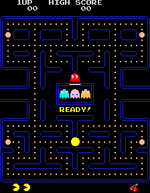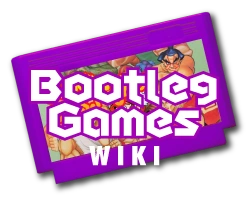Also check out the Pac-Man wiki's page on the history of Pac-Man clones and bootlegs.
Pac-Man (パックマン), is an arcade game developed by Namco and first released in Japan in May 1980. It was created by Japanese video game designer Toru Iwatani. It was licensed for distribution in the United States by Midway Games and released in October 1980. Immensely popular from its original release to the present day, Pac-Man is considered one of the classics of the medium, and an icon of 1980's popular culture.
Pac-Man[]

Pac-Man gameplay.
Pac-Man is an arcade game first released in Japan in May 1980. Developed by Namco, currently known as Bandai Namco Entertainment, it was the debut title in the Pac-Man series. The game was not intended to be too popular at first, but when released, the game was a huge success and is now the highest-grossing arcade game of all time. This resulted in many sequels and spin-offs of the game, including Ms. Pac-Man. The game has been cloned innumerable times, and re-released on many systems and in many compilations. The player controls Pac-Man, whose design is a yellow circle with a pie wedge shaped mouth, to eat pellets called "Pac-Dots" through a maze. When all dots are eaten, Pac-Man is taken to the next stage. Four ghosts, Blinky, Pinky, Inky and Clyde roam the maze, trying to catch Pac-Man. If a ghost chomps (touches) Pac-Man, a life is lost. When all lives have been lost, the game ends. However, there are also four larger, flashing dots near the corners of the maze known as Power Pellets, which provide Pac-Man with the temporary ability to eat the ghosts, which will turn blue, reverse direction, and move slower for a short period of time. In addition, bonus items, usually referred to as fruits (though not all items are fruits) occasionally appear near the center of the maze, and they score extra bonus points when eaten. The items change and bonus values increase throughout the game. Owing to its popularity and surface-level simplicity, many unofficial ports and remakes exist for various systems, including Shit (MSX) and the "Pacman" game in Pokémon 4-in-1, and many more bootlegs are forged from hacks of Pac-Man's source code, such as Abscam and Hangly-Man.
Ms. Pac-Man[]
Ms. Pac-Man is a semi-official sequel to Pac-Man that started life as a ROM hack made by GCC. While it doesn't have nearly as many proper bootlegs as the original game, Namco did give them permission to create a port of the game that was ultimately unlicensed by Nintendo. This port has a few reskins, such as Ms. Powerball.
A strange hack of Ms. Pac-Man on arcades known as Club Lambada is... well, it's certainly a hack that exists.
Pac-Mania[]
Pac-Mania is the Pac-Man series's first jump to 3D, and we mean that literally, as in Pac-Man literally jumps in 3D. Only one "bootleg" is known of Pac-Mania, and much like Ms. Pac-Man, it's in a grey area because it's licensed by Namco but not by Nintendo.
Pac-Pirates[]
Many games have been made in Pac-Man's image without directly copying one of the games. These include the Hyper Pacman series (which are closest in style to Pac-Man Arrangement, but with the jump mechanics of Pac-Mania and generic ghosts that don't fit with any official Pac-Man game) and Puckman Pockimon.
| List of Franchises |
|---|
|
Contra · Crayon Shin-Chan · Donkey Kong · Doraemon ·Dragon Ball · Mario · Mega Man · Pac-Man · Sonic · Street Fighter |

